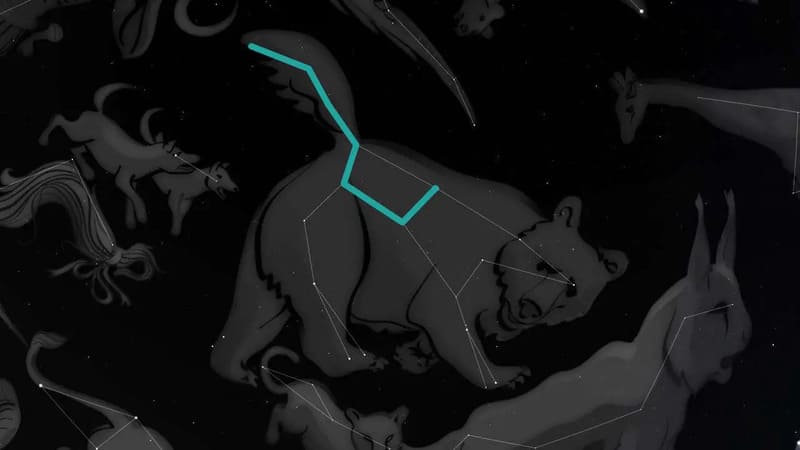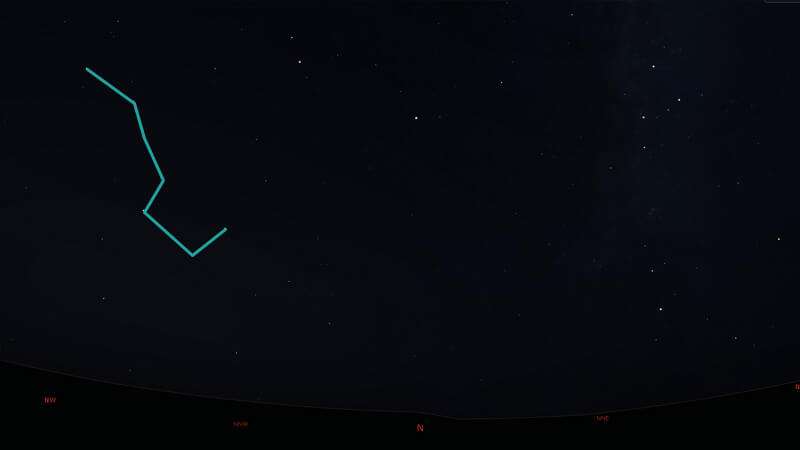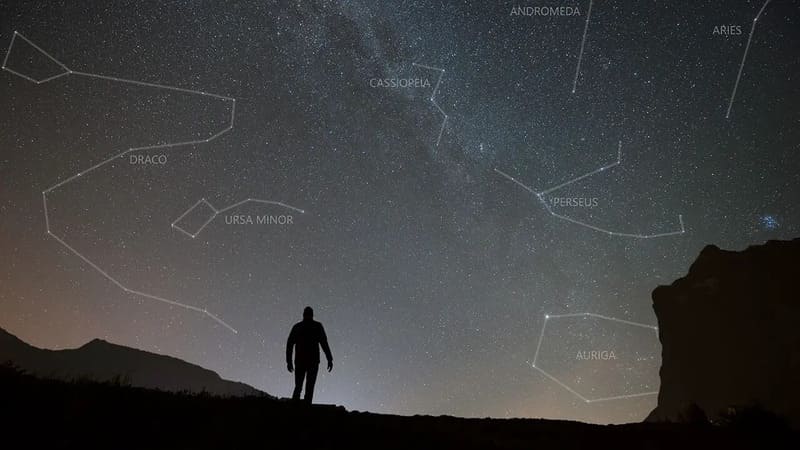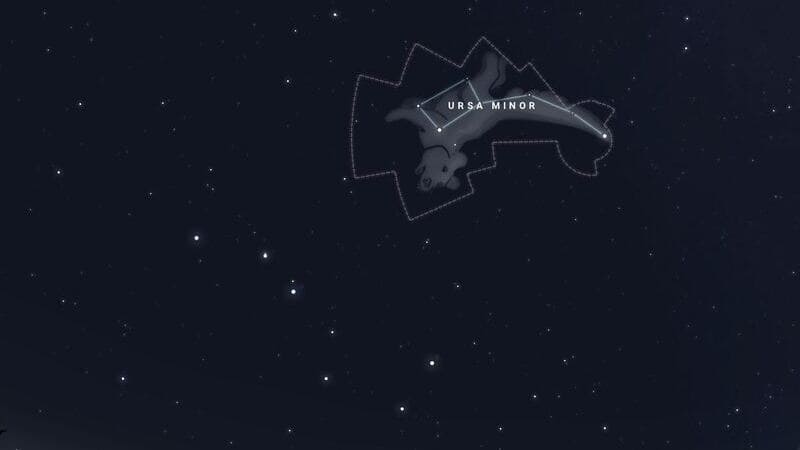As twilight descends and the stars twinkle into view, one celestial pattern captures our imagination like no other—the captivating Big Dipper. But have you ever wondered, “How far away is the Big Dipper?”
The Big Dipper is not a single object or entity that can be measured in distance. Instead, it’s an asterism—a pattern of stars—that appears in the constellation Ursa Major. The stars that form the Big Dipper are at varying distances from Earth. Individually, the stars of the Big Dipper are relatively close in astronomical terms, ranging from about 63 to 123 light-years away. However, the entire Ursa Major constellation, of which the Big Dipper is a part, is much farther, at an average distance of about 78 light-years from Earth.
In this article, we’ll take you on a journey through the universe to explore the Big Dipper asterism and its mysteries. We’ll cover everything from the basics, such as what the Big Dipper is and how to find it in the northern sky, to more advanced topics, like its use in celestial navigation and its cultural significance throughout history.
In a nutshell:
- The Big Dipper is a well-known asterism consisting of seven bright stars in the constellation Ursa Major. It is easily recognizable from North America and serves as a guidepost in the night sky for stargazers and celestial navigators.
- The stars within the Big Dipper have their own unique characteristics and positions. They play essential roles in celestial navigation, with some stars indicating the North Star, Polaris, and others forming the “Pointer Stars” that guide the way.
- The Big Dipper holds cultural significance across various mythologies and folklore, from Greek mythology’s tale of Zeus and Callisto to Native American legends and Finnish folklore.
In this article, you get to
Discover the origins and composition of the Big Dipper, a famous asterism in the constellation Ursa Major.
Understand the individual characteristics and positions of each star within the Big Dipper.
Learn practical tips for locating and identifying the Big Dipper in the night sky, including its circumpolar nature and the use of pointer stars.
Explore the significance of the Big Dipper in celestial navigation and its role in finding the North Star, Polaris.
Uncover the fascinating mythological and cultural connections surrounding the Big Dipper across different civilizations.
Gain insights into the celestial objects and constellations near the Big Dipper, such as Ursa Minor, Arcturus, and Spica.
Discover how the Big Dipper has influenced popular culture, appearing in songs, books, and movies.
Recognize the role of the Big Dipper in Native American folklore, Greek mythology, and Finnish tales.
Appreciate the beauty and wonder of the night sky, encouraging readers to explore and observe other celestial objects beyond the Big Dipper.
By the end of this article, you’ll be captivated by the celestial secrets of the Big Dipper, armed with practical knowledge to locate it in the night sky, enriched with fascinating mythological tales, and inspired to embark on your own cosmic exploration.
Let’s dive right in.
Recommended For You
What is the Big Dipper?

The Big Dipper is a well-known asterism, or pattern of stars, in the constellation Ursa Major, or the Great Bear. It comprises seven bright stars easily visible to the naked eye in the northern hemisphere.
Here is the name of each Big Dipper star and its apparent magnitude
- Alkaid 1.84
- Megrez 3.31
- Dubhe 1.79
- Merak 2.37
- Mizar 2.23
- Alioth 1.76
- Phecda 2.41
The Big Dipper’s seven stars have their own individual names and characteristics, but together they form one of the most recognizable patterns of stars in the night sky.
Understanding the Components of the Big Dipper

Each star has unique characteristics and plays an essential role in the constellation.
Here is each star’s position and characteristic
- Alkaid: End star of the handle. Has a binary star companion.
- Mizar: Middle star of the handle. Has a visual companion star called Alcor.
- Alioth: Last star in the bowl. Has a very high rotational velocity.
- Megrez: Second star in the bowl. Indicates the direction to the North Pole.
- Dubhe: First star in the bowl. A “Pointer Star” that points towards the North Star.
- Merak: Third star in the bowl. Part of the “Pointer Stars” that point towards the North Star.
- Phecda: Fourth star in the bowl. The second brightest star in the Big Dipper
The stars of the Big Dipper are part of a larger constellation called Ursa Major, which translates to “the Great Bear.” Despite its name, the Big Dipper is not officially recognized as a constellation but rather as an asterism, a recognizable pattern of stars within a larger constellation.
Fun Fact

The stars of the Big Dipper are all part of a group of stars called the Ursa Major Moving Group, which share a common origin and are moving through space together. This group also includes the Little Dipper stars, including the North Star, Polaris.
Locating the Big Dipper in the Night Sky

If you’re in the northern hemisphere, locating the Big Dipper is relatively easy. Look towards the northern horizon and find the seven bright stars that make up this easily recognizable constellation.
One helpful trick for finding the Big Dipper is to locate the North Star, aka Polaris. The North Star is the brightest in the constellation Ursa Minor, and it’s always located due north.
Once you’ve located Polaris, remember that the Big Dipper is always visible in the night sky, year-round. Because it’s a circumpolar constellation, it never dips below the horizon.
Locating the Big Dipper Using Degrees
If you need help finding the Big Dipper, you can use degrees to help you. Stand facing Polaris, and look up toward the sky. The Big Dipper will appear to be located about 30 from Polaris.
Another way to locate the Big Dipper is by using the “pointer stars,” which are the two stars that form the edge of the “bowl” opposite the handle. The pointer stars point towards Polaris, making it easy to locate.
The Big Dipper and Celestial Navigation
The stars can be your guide if you find yourself lost in the wilderness without a compass or map. One of the most recognizable constellations in the northern hemisphere is the Big Dipper, making it an essential tool for celestial navigation.
Using the Big Dipper for navigation is easy once you know how to locate it in the night sky. Look to the northern horizon and find the two stars forming the bowl’s outer edge. These stars, Dubhe and Merak, point towards the North Star, Polaris.
As the Earth rotates, the Big Dipper appears to rotate around Polaris, making it a circumpolar constellation. This means it is visible in the night sky year-round in the northern hemisphere.
In addition to its practical uses, the Big Dipper has cultural significance in many societies.
In Greek mythology, it is known as the Plough or the Great Wagon.
In Finland, it is called the Otava; in India, it is known as the Saptarishi or the seven sages.
The shape of the Big Dipper also resembles a saucepan or ladle, giving it a relatable nickname.
Whether you’re a seasoned navigator or just starting to explore the night sky, the Big Dipper is a must-know constellation. Use it to guide your way and appreciate its beauty as part of the vast universe above us.
Other Celestial Objects in the Vicinity of the Big Dipper

While the Big Dipper is one of the most well-known constellations, it is not alone in the night sky.
Here are some other notable celestial objects in the vicinity of the Big Dipper:
- Arcturus: One of the brightest stars in the sky and part of the constellation Boötes. Arcturus can be found by following the arc of the Big Dipper’s handle.
- Spica: Another of the brightest stars in the sky, Spica is the brightest star in the constellation Virgo. It can be found by following a line through the Big Dipper’s handle.
- Draco: A long and winding constellation that passes near the North Star. Draco is a circumpolar constellation, meaning it never sets below the horizon.
- Little Dipper: Also known as Ursa Minor, the Little Dipper is a smaller version of the Big Dipper and contains the North Star, Polaris.
- Leo: A large and prominent constellation with many bright stars, including Regulus, one of the brightest stars in the sky.
In addition to these objects, many other constellations and stars are visible in the night sky, depending on the time of year and location.
The Big Dipper’s Connection to Ursa Minor

The Big Dipper is part of the constellation Ursa Major or the Great Bear. However, it is also closely connected to another constellation, Ursa Minor, also known as the Little Bear. Ursa Minor contains the North Star, Polaris, close to the North Celestial Pole.
Ursa Major and Ursa Minor are members of the Ursa Major Moving Group, a group of stars that share a joint motion through space. This group also includes other notable constellations such as Draco and Canes Venatici. The Ursa Major Moving Group was originally part of a larger group known as the Ursa Major Moving Cluster, which is believed to have formed about 500 million years ago.
The connection between the Big Dipper and Ursa Minor is not limited to their membership in the same moving group.
One of the most famous Greek mythology tales tells how the two constellations came to be.
The story goes that Zeus had an affair with a mortal woman named Callisto, a follower of the goddess Artemis. When Artemis discovered the affair, she turned Callisto into a bear. Years later, Callisto’s son Arcas almost killed her while hunting, but Zeus intervened and turned them into constellations – Ursa Major and Ursa Minor – to keep them safe from harm. In this story, the Big Dipper represents the tail and hindquarters of the bear, while the Little Dipper represents the bear itself.
Today, the Big Dipper and Ursa Minor remain two of the night sky’s most recognizable and beloved constellations. They continue to inspire awe and wonder in stargazers, young and old. Their connection reminds us of the rich history and mythology surrounding the stars above us.
The Big Dipper in Mythology and Folk Tales
The Big Dipper has been a prominent feature in mythology and folk tales across cultures.
In Greek mythology, the constellation was known as the Plough and associated with Demeter, the goddess of agriculture and fertility.
In other cultures, the Big Dipper was called the Great Wagon, Otava, or Saptarishi, among other names.
The Big Dipper in Native American Mythology
Native American tribes also had myths and legends surrounding the Big Dipper.
The Lakota referred to it as the “hoop of the nation” and believed that the seven stars represented seven council fires of the Lakota people. The Anishinaabe people saw the shape of a bear in the constellation and called it the “little bear” or “great bear.”
The Big Dipper has been used as a navigational tool throughout history.
The constellation is not visible year-round in the Southern Hemisphere, so ancient mariners used it to navigate north. Sailors in the Northern Hemisphere used the Big Dipper to find Polaris, the North Star.
The Big Dipper in Finnish Folklore
In Finnish folklore, the Big Dipper is known as the “saucepan” and is said to have been stolen from the sky by the hero Väinämöinen. It is also associated with the god Ukko, the god of thunder and the sky.
The Big Dipper has also had a significant impact on popular culture. It has been featured in numerous songs, movies, and books, including the children’s book “Follow the Drinking Gourd,” which tells how the Big Dipper was used as a guide for runaway slaves on the Underground Railroad.
Notable Stars and Objects in Other Constellations
While the Big Dipper is undoubtedly one of the most well-known constellations, many other stars and objects in the night sky are worth exploring.
Here are some other notable celestial bodies you can spot in the vicinity of the Big Dipper:
- Hydra: Alphard, which means “the solitary one” in Arabic, is the brightest star in Hydra and part of the constellation’s head.
- Canes Venatici: This constellation is home to the Whirlpool Galaxy, a spiral galaxy located approximately 23 million light-years from Earth.
- Castor: Castor is a binary star system located in the constellation Gemini and is one of the brightest stars in the night sky.
- Auriga: Capella, a yellow giant star, is the brightest star in Auriga and the sixth-brightest star in the night sky.
- Leo: Regulus is the brightest star in Leo and one of the brightest stars in the night sky. It is also part of the Winter Hexagon, a six-sided shape formed by six bright stars during the winter season.
- Hydra: Alphard, which means “the solitary one” in Arabic, is the brightest star in Hydra and part of the constellation’s head.
These are just a few examples of the many fascinating stars and objects in the night sky. Take some time to explore and discover the wonders of the universe!
Frequently Asked Questions about the Big Dipper
Here are some common questions about the Big Dipper that people often ask.
How close is the Big Dipper to the Little Dipper?
While separate, the Big Dipper and the Little Dipper are close neighbors in the night sky. They may appear near each other, but they are at different distances from Earth. When we gaze up at the stars, we see them as they were in the past because starlight takes time to reach us. The Big Dipper is about 63 to 123 light-years away from us, while the Little Dipper, also known as Ursa Minor, is approximately 124 light-years away.
Where can I locate the Big Dipper in the sky?
To locate the Big Dipper in the sky, you must look towards the northern horizon. It’s easy to find! Imagine a large ladle or a saucepan floating in the heavens. The Big Dipper consists of seven bright stars that form the shape of a bowl with a long handle. Remember, it’s part of the larger constellation Ursa Major, which means “Great Bear.” If you can spot the constellation Ursa Major, you’ll spot the Big Dipper too.
What is the distance to the Big Dipper in light years?
The distance to the individual stars of the Big Dipper varies, ranging from approximately 63 to 123 light-years away. This means that the light we see from the stars of the Big Dipper today left those stars 63 to 123 years ago. A light-year is the distance that light travels in one year, which is about 5.88 trillion miles or 9.46 trillion kilometers. When we look at the Big Dipper, we observe the light that left those stars several decades ago.
How large does the Big Dipper appear?
In terms of size, the Big Dipper appears quite prominent in the sky. The distance between the stars that form the bowl ranges from about 10 to 25 light-years. When we look up, these stars seem close together, almost like they’re dipping right above us. However, remember that their actual distances vary, with some stars closer to us than others. It’s like a cosmic illusion!
How many stars form the Big Dipper?
The Big Dipper comprises seven stars, each contributing to its unique shape and charm. These stars have their own names, such as Dubhe, Merak, and Alioth, which are part of the bowl, and Alkaid, Mizar, Megrez, and Phecda, which form the handle. Together, they create a stunning pattern that has captivated skywatchers for centuries.
What is the light travel time from the Big Dipper to Earth?
The light travel time from the Big Dipper to Earth depends on the specific stars of the constellation. The stars of the Big Dipper are located at varying distances from us within the Ursa Major constellation. The distances to these stars range from approximately 63 to 123 light-years away. The light we see from the stars of the Big Dipper today left those stars 63 to 123 years ago.
Summary: How Far Away is the Big Dipper
Thank you for reading my article “How Far Away is the Big Dipper?”
The Big Dipper is a fascinating constellation that has captured the attention of stargazers for generations. Understanding its components and location in the night sky can deepen our appreciation for the universe and its complexities.
Whether you’re a seasoned astronomer or a novice skywatcher, the Big Dipper has something to offer. It can serve as a guide for celestial navigation and a point of reference for other significant constellations.
As we’ve seen, the Big Dipper has played a significant role in cultures worldwide, from ancient Greek mythology to modern-day Finnish folklore. Its enduring popularity speaks to its enduring beauty and mystery.
Happy Stargazing!




